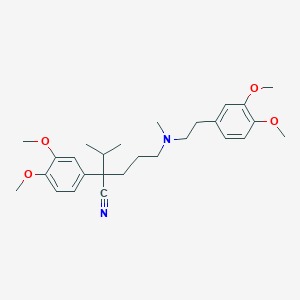Attribution Statement: LactMed is a registered trademark of the U.S. Department of Health and Human Services.
NCBI Bookshelf. A service of the National Library of Medicine, National Institutes of Health.
Drugs and Lactation Database (LactMed®) [Internet]. Bethesda (MD): National Institute of Child Health and Human Development; 2006-.
CASRN: 52-53-9

Drug Levels and Effects
Summary of Use during Lactation
Limited information indicates that maternal doses of verapamil up to 360 mg daily produce low levels in milk. Newborns may have detectable verapamil serum levels, but levels are low. Verapamil would not be expected to cause any adverse effects in breastfed infants, especially if the infant is older than 2 months.
Drug Levels
Maternal Levels. The first 2 cases of verapamil excretion in milk found disparate results.[1][2] In one, milk levels ranging from 19 to 38 mcg/L were found at various times during a dosing regimen of 80 mg orally 3 times daily in a mother who was 3 to 5 days postpartum. Milk levels averaged 23% of serum levels.[2] In the second woman who was 13 days postpartum, milk levels peaked at about 300 mcg/L about 1 hour after each 80 mg dose in a 80 mg 4 times daily regimen and were approximately equal to serum levels at most times.[1]
In 2 later cases (below), plasma and milk verapamil and norverapamil levels were measured using more accurate methods. The results reported in these 2 papers were consistent with each other and differed from both of the earlier studies in some aspects.[3][4]
A woman who was 8 weeks postpartum and taking 120 mg of verapamil orally every 8 hours had milk verapamil levels of 113 and 154 mcg/L of verapamil just before a dose, with the higher level occurring later in the feeding, probably because of the higher fat content. At 4 hours after a dose, levels were 133 and 205 mcg/L early and late in the feeding, respectively. Norverapamil levels were similar early and late in each feeding and averaged 50 mcg/L before the dose and 58 mcg/L at 4 hours. The authors estimated that a nursing infant would receive less than 0.5% of the mother's weight-adjusted dosage.[3]
A 3-month-postpartum woman taking verapamil 80 mg orally three times daily had peak milk levels of verapamil of 79 mcg/L 1 hour after the dose and norverapamil of 22 mcg/L 2 hours after the dose. The authors estimated that a nursing infant would receive less than 0.01% of the mother's weight-adjusted dose daily.[4]
Infant Levels. A serum level of 2.1 mcg/L was reported in a 5-day-old infant whose mother was taking 80 mg of verapamil orally 3 times daily. It is possible that some of the drug in the infant's serum derived from transplacental passage, although the mother received no verapamil on the day of delivery.[2]
Two older infants (8 weeks and 3 months) had no detectable serum verapamil or norverapamil (<1 mcg/L) with oral maternal doses of 80 and 120 mg 3 times daily.[3][4]
Effects in Breastfed Infants
No adverse reactions have been reported among 3 infants aged 13 days, 8 weeks and 3 months who were exposed to verapamil in breastmilk.[2][3][4]
Effects on Lactation and Breastmilk
Verapamil can cause hyperprolactinemia and galactorrhea.[5][6] The clinical relevance of these findings in nursing mothers is not known. The maternal prolactin level in a mother with established lactation may not affect her ability to breastfeed.
Alternate Drugs to Consider
(Calcium Channel Blockers) Diltiazem, Nifedipine; (Hypertension) Enalapril, Hydrochlorothiazide, Methyldopa, Propranolol
References
- 1.
- Inoue H, Unno N, Ou MC et al. Level of verapamil in human milk. Eur J Clin Pharmacol. 1984;26:657-8. [PubMed: 6468488]
- 2.
- Andersen HJ. Excretion of verapamil in human milk. Eur J Clin Pharmacol. 1983;25:279-80. Letter. [PubMed: 6628513]
- 3.
- Miller MR, Withers R, Bhamra R et al. Verapamil and breast-feeding. Eur J Clin Pharmacol. 1986;30:125-6. [PubMed: 3709626]
- 4.
- Anderson P, Bondesson U, Mattiasson I et al. Verapamil and norverapamil in plasma and breast milk during breast feeding. Eur J Clin Pharmacol. 1987;31:625-7. [PubMed: 3830249]
- 5.
- Gluskin LE, Strasberg B, Shah JH. Verapamil-induced hyperprolactinemia and galactorrhea. Ann Intern Med. 1981;95:66-7. [PubMed: 7195677]
- 6.
- Fearrington EL, Rand CH Jr, Rose JD. Hyperprolactinemia-galactorrhea induced by verapamil. Am J Cardiol. 1983;51:1466-7. [PubMed: 6682619]
Substance Identification
Substance Name
Verapamil
CAS Registry Number
52-53-9
Drug Class
- Breast Feeding
- Antihypertensive Agents
- Calcium Channel Blockers
- Antiarrhythmics
- Vasodilator Agents
Disclaimer: Information presented in this database is not meant as a substitute for professional judgment. You should consult your healthcare provider for breastfeeding advice related to your particular situation. The U.S. government does not warrant or assume any liability or responsibility for the accuracy or completeness of the information on this Site.
- User and Medical Advice Disclaimer
- Drugs and Lactation Database (LactMed) - Record Format
- LactMed - Database Creation and Peer Review Process
- Fact Sheet. Drugs and Lactation Database (LactMed)
- Drugs and Lactation Database (LactMed) - Glossary
- LactMed Selected References
- Drugs and Lactation Database (LactMed) - About Dietary Supplements
- Breastfeeding Links
- PubChem SubstanceRelated PubChem Substances
- PubMedLinks to PubMed
- Review Desipramine.[Drugs and Lactation Database (...]Review Desipramine.. Drugs and Lactation Database (LactMed®). 2006
- Review Trifluoperazine.[Drugs and Lactation Database (...]Review Trifluoperazine.. Drugs and Lactation Database (LactMed®). 2006
- Review Clobazam.[Drugs and Lactation Database (...]Review Clobazam.. Drugs and Lactation Database (LactMed®). 2006
- Review Pindolol.[Drugs and Lactation Database (...]Review Pindolol.. Drugs and Lactation Database (LactMed®). 2006
- Review Cyclosporine.[Drugs and Lactation Database (...]Review Cyclosporine.. Drugs and Lactation Database (LactMed®). 2006
- Verapamil - Drugs and Lactation Database (LactMed®)Verapamil - Drugs and Lactation Database (LactMed®)
Your browsing activity is empty.
Activity recording is turned off.
See more...
